Genome-Wide Association Study on Root System Architecture and Identification of Candidate Genes in Wheat (Triticum aestivum L.)
Abstract
:1. Introduction
2. Results
2.1. Population Structure and Linkage Disequilibrium (LD) Decay Analysis
2.2. Phenotypic Variation of the RSA Traits
2.3. Correlations between RSA Traits
2.4. GWAS of RSA Traits
2.5. QTL Clusters for Root System Architecture Traits
2.6. Candidate Genes Associated with RSA
3. Discussion
3.1. Soil Culture and 660K SNp Chip Are Ideal Methods for GWAS of RSA Traits in Wheat
3.2. QTL Analysis for RSA Traits
3.3. QTL Analysis Reveals the Key Genes for RSA
4. Materials and Methods
4.1. Plant Materials and Experimental Treatment
4.2. RSA Trait Measurement
4.3. Phenotypic Data Analysis for RSA Traits
4.4. Population Structure
4.5. LD Analysis
4.6. Genotyping Data Using 660K SNp Chip
4.7. GWAS
4.8. Candidate Gene Identification, RNA Extraction, and RT-qPCR Verification
Supplementary Materials
Author Contributions
Funding
Institutional Review Board Statement
Informed Consent Statement
Data Availability Statement
Conflicts of Interest
References
- Ray, D.K.; Mueller, N.D.; West, P.C.; Foley, J.A. Yield Trends Are Insufficient to Double Global Crop Production by 2050. PLoS ONE 2013, 8, e66428. [Google Scholar] [CrossRef] [PubMed] [Green Version]
- Sharma, I.; Tyagi, B.S.; Singh, G.; Venkatesh, K.; Gupta, O.P. Enhancing wheat production-A global perspective. Indian J. Agric. Sci. 2015, 85, 3–13. [Google Scholar]
- Wheeler, T.; Braun, J.V. Climate Change Impacts on Global Food Security. Science 2013, 341, 508–513. [Google Scholar] [CrossRef] [PubMed]
- Zampieri, M.; Ceglar, A.; Dentener, F.; Toreti, A. Wheat yield loss attributable to heat waves, drought and water excess at the global, national and subnational scales. Environ. Res. Lett. 2017, 12, 064008. [Google Scholar] [CrossRef]
- Maccaferri, M.; El-Feki, W.; Nazemi, G.; Salvi, S.; Canè, M.A.; Colalongo, M.C.; Stefanelli, S.; Tuberosa, R. Prioritizing quantitative trait loci for root system architecture in tetraploid wheat. J. Exp. Bot. 2016, 67, 1161–1178. [Google Scholar] [CrossRef]
- Atkinson, J.A.; Pound, M.P.; Bennett, M.J.; Wells, D.M. Uncovering the hidden half of plants using new advances in root phenotyping. Curr. Opin. Biotechnol. 2019, 55, 1–8. [Google Scholar] [CrossRef]
- Li, X.K.; Guo, Z.L.; Lv, Y.; Cen, X.; Ding, X.P.; Wu, H.; Li, X.H.; Huang, J.P.; Xiong, L.Z. Genetic control of the root system in rice under normal and drought stress conditions by genome-wide association study. PLOS Genet. 2017, 13, e1006889. [Google Scholar] [CrossRef] [Green Version]
- Chen, X.X.; Ding, Q.S.; Błaszkiewicz, Z.; Sun, J.A.; Sun, Q.; He, R.Y.; Li, Y.N. Phenotyping for the dynamics of field wheat root system architecture. Sci. Rep. 2017, 7, 37649. [Google Scholar] [CrossRef] [Green Version]
- Huang, C.Y.; Kuchel, H.; Edwards, J.; Hall, S.; Parent, B.; Eckermann, P.; Herdina; Hartley, D.M.; Langridge, P.; McKay, A.C. A DNA-based method for studying root responses to drought in field-grown wheat genotypes. Sci. Rep. 2013, 3, 3194. [Google Scholar] [CrossRef] [Green Version]
- Manschadi, A.M.; Hammer, G.L.; Christopher, J.T.; Devoil, P. Genotypic variation in seedling root architectural traits and implications for drought adaptation in wheat (Triticum aestivum L.). Plant Soil 2008, 303, 115–129. [Google Scholar] [CrossRef]
- Voss-Fels, K.P.; Qian, L.; Parra-Londono, S.; Uptmoor, R.; Frisch, M.; Keeble-Gagnère, G.; Apples, R.; Snowdon, R.J. Linkage drag constrains the roots of modern wheat. Plant Cell Environ. 2017, 40, 717–725. [Google Scholar] [CrossRef] [PubMed]
- Man, J.; Shi, Y.; Yu, Z.; Zhang, Y. Dry Matter Production, Photosynthesis of Flag Leaves and Water Use in Winter Wheat Are Affected by Supplemental Irrigation in the Huang-Huai-Hai Plain of China. PLoS ONE 2015, 10, e0137274. [Google Scholar] [CrossRef] [PubMed] [Green Version]
- Wasaya, A.; Zhang, X.Y.; Fang, Q.; Yan, Z.Z. Root Phenotyping for Drought Tolerance: A Review. Agronomy 2018, 8, 241. [Google Scholar] [CrossRef] [Green Version]
- Christopher, J.; Christopher, M.; Jennings, R.; Jones, S.; Fletcher, S.; Borrell, A.; Manschadi, B.A.; Jordan, D.; Mace, E.; Hammer, G. QTL for root angle and number in a population developed from bread wheats (Triticum aestivum) with contrasting adaptation to water-limited environments. Theor. Appl. Genet. 2013, 126, 1563–1574. [Google Scholar] [CrossRef] [PubMed]
- Bai, C.H.; Liang, Y.L.; Hawkesford, M.J. Identification of QTLs associated with seedling root traits and their correlation with plant height in wheat. J. Exp. Bot. 2013, 64, 1745–1753. [Google Scholar] [CrossRef] [Green Version]
- Zhang, W.P.; Shen, X.Y.; Wu, P.; Hu, B.; Liao, C.Y. QTLs and epistasis for seminal root length under a different water supply in rice (Oryza sativa L.). Theor. Appl. Genet. 2001, 103, 118–123. [Google Scholar] [CrossRef]
- Li, P.C.; Fan, Y.Y.; Yin, S.Y.; Wang, Y.Y.; Wang, H.M.; Xu, Y.; Yang, Z.F.; Xu, C.W. Multi-environment QTL mapping of crown root traits in a maize RIL population. Crop J. 2020, 8, 645–654. [Google Scholar] [CrossRef]
- Wu, Y.D.; Zhang, S.F.; Zhang, H.; Li, F.; Li, G.L.; Fan, C.C.; Sun, R.F.; Zhang, S.J. QTL mapping and candidate gene identification of swollen root formation in Turnip. Int. J. Mol. Sci. 2021, 22, 653. [Google Scholar] [CrossRef]
- Ren, Y.; Qian, Y.; Xu, Y.; Zou, C.; Liu, D.; Zhao, X.; Zhang, A.; Tong, Y. Characterization of QTLs for Root Traits of Wheat Grown under Different Nitrogen and Phosphorus Supply Levels. Front. Plant Sci. 2017, 8, 2096. [Google Scholar] [CrossRef] [Green Version]
- Steele, K.A.; Price, A.H.; Witcombe, J.R.; Shrestha, R.; Singh, B.N.; Gibbons, J.M.; Virk, D.S. QTLs associated with root traits increase yield in upland rice when transferred through marker-assisted selection. Theor. Appl. Genet. 2012, 126, 101–108. [Google Scholar] [CrossRef]
- Li, C.N.; Li, L.; Reynolds, M.P.; Wang, J.Y.; Chang, X.P.; Mao, X.G.; Jing, R.L. Recognizing the hidden half in wheat: Root system attributes associated with drought tolerance. J. Exp. Bot. 2021, 72, 5117–5133. [Google Scholar] [CrossRef] [PubMed]
- Liu, P.; Jin, Y.R.; Liu, J.D.; Liu, C.Y.; Yao, H.P.; Luo, F.Y.; Guo, Z.H.; Xia, X.C.; He, Z.H. Genome-wide association mapping of root system architecture traits in common wheat (Triticum aestivum L.). Euphytica 2019, 215, 121. [Google Scholar] [CrossRef]
- Alemu, A.; Feyissa, T.; Maccaferri, M.; Sciara, G.; Tuberosa, R.; Ammar, K.; Badebo, A.; Acevedo, M.; Letta, L.; Abeyo, B. Genome-wide association analysis unveils novel QTLs for seminal root system architecture traits in Ethiopian durum wheat. BMC Genom. 2021, 22, 20. [Google Scholar] [CrossRef] [PubMed]
- Fan, X.L.; Zhang, W.; Zhang, N.; Chen, M.; Zheng, S.S.; Zhao, C.H.; Han, J.; Liu, J.J.; Zhang, X.L.; Song, L.Q.; et al. Identification of QTL regions for seedling root traits and their effect on nitrogen use efficiency in wheat (Triticum aestivum L.). Theor. Appl. Genet. 2018, 131, 2677–2698. [Google Scholar] [CrossRef]
- Salarpour, M.; Pakniyat, H.; Abdolshahi, R.; Heidari, B.; Razi, H.; Afzali, R. Mapping QTL for agronomic and root traits in the Kukri/RAC875 wheat (Triticum aestivum L.) population under drought stress conditions. Euphytica 2020, 216, 105. [Google Scholar] [CrossRef]
- Huang, F.; Chen, Z.Y.; Du, D.J.; Guan, P.F.; Chai, L.L.; Guo, W.L.; Hu, Z.R.; Xin, M.M.; Peng, H.R.; Yao, Y.Y.; et al. Genome-wide linkage mapping of QTL for root hair length in a Chinese common wheat population. Crop J. 2020, 8, 1049–1056. [Google Scholar] [CrossRef]
- Yang, M.J.; Wang, C.R.; Hassan, M.A.; Li, F.J.; Xia, X.C.; Shi, S.B.; Xiao, Y.G.; He, Z.H. QTL mapping of root traits in wheat under different phosphorus levels using hydroponic culture. BMC Genom. 2021, 22, 174. [Google Scholar] [CrossRef]
- Xu, F.D.; Chen, S.L.; Yang, X.W.; Zhou, S.M.; Wang, J.S.; Zhang, Z.L.; Huang, Y.; Song, M.; Zhang, J.; Zhan, K.H.; et al. Genome-Wide Association Study on Root Traits Under Different Growing Environments in Wheat (Triticum aestivum L.). Front. Genet. 2021, 12, 646712. [Google Scholar] [CrossRef]
- Li, Z.X.; Ni, Z.F.; Peng, H.R.; Liu, Z.Y.; Nie, X.L.; Xu, S.B.; Liu, G.; Sun, Q.X. Molecular mapping of QTLs for root response to phosphorus deficiency at seedling stage in wheat (Triticum aestivum L.). Prog. Nat. Sci. 2007, 17, 1177–1184. [Google Scholar]
- Yang, M.J.; Wang, C.R.; Hassan, M.A.; Wu, Y.Y.; Xia, X.C.; Shi, S.B.; Xiao, Y.G.; He, Z.H. QTL mapping of seedling biomass and root traits under different nitrogen conditions in bread wheat (Triticum aestivum L.). J. Integr. Agric. 2021, 20, 1180–1192. [Google Scholar] [CrossRef]
- Li, T.; Ma, J.; Zou, Y.Y.; Chen, G.D.; Ding, P.Y.; Zhang, H.; Lan, X.J. Quantitative trait loci for seeding root traits and the relationships between root and agronomic traits in common wheat. Genome 2019, 63, 27–36. [Google Scholar] [CrossRef]
- Zheng, X.W.; Wen, X.J.; Qiao, L.; Zhao, J.J.; Zhang, X.J.; Li, X.; Zheng, J. A novel QTL QTrl.saw-2D.2 associated with the total root length identified by linkage and association analyses in wheat (Triticum aestivum L.). Planta 2019, 250, 129–143. [Google Scholar] [CrossRef]
- Kabir, M.R.; Liu, G.; Guan, P.; Wang, F.; Khan, A.A.; Ni, Z.; Sun, Q. Mapping QTLs associated with root traits using two different populations in wheat (Triticum aestivum L.). Euphytica 2015, 206, 175–190. [Google Scholar] [CrossRef]
- Soriano, J.M.; Alvaro, F. Discovering consensus genomic regions in wheat for root-related traits by QTL meta-analysis. Sci. Rep. 2019, 9, 10537. [Google Scholar] [CrossRef] [PubMed] [Green Version]
- Roselló, M.; Royo, C.; Sanchez-Garcia, M.; Soriano, J.M. Genetic Dissection of the Seminal Root System Architecture in Mediterranean Durum Wheat Landraces by Genome-Wide Association Study. Agronomy 2019, 9, 364. [Google Scholar] [CrossRef] [Green Version]
- Iannucci, A.; Marone, D.; Russo, M.A.; De Vita, P.; Miullo, V.; Ferragonio, P.; Mastrangelo, A.M. Mapping QTL for Root and Shoot Morphological Traits in a Durum Wheat × T. dicoccum Segregating Population at Seedling Stage. Int. J. Genom. 2017, 2017, 1–17. [Google Scholar] [CrossRef] [PubMed] [Green Version]
- Ibrahim, S.E.; Schubert, A.; Pillen, K.; Léon, J. QTL analysis of drought tolerance for seedling root morphological traits in an advanced backcross population of spring wheat. Int. J. Agric. Sci. 2012, 2, 619–629. [Google Scholar]
- Xie, Q.; Fernando, K.M.C.; Mayes, S.; Sparkes, D.L. Identifying seedling root architectural traits associated with yield and yield components in wheat. Ann. Bot. 2017, 119, 1115–1129. [Google Scholar] [CrossRef] [PubMed]
- Ma, J.; Luo, W.; Zhang, H.; Zhou, X.H.; Qin, N.N.; Wei, Y.M.; Liu, Y.X.; Jiang, Q.T.; Lan, X.J. Identification of quantitative trait loci for seedling root traits from Tibetan semi-wild wheat (Triticum aestivum subsp. tibetanum). Genome 2017, 60, 1068–1075. [Google Scholar] [CrossRef] [PubMed] [Green Version]
- Atkinson, J.A.; Wingen, L.U.; Griffiths, M.; Pound, M.P.; Gaju, O.; Foulkes, M.J.; Wells, D.M. Phenotyping pipeline reveals major seedling root growth QTL in hexaploid wheat. J. Exp. Bot. 2015, 66, 2283–2292. [Google Scholar] [CrossRef] [Green Version]
- Merchuk-Ovnat, L.; Fahima, T.; Ephrath, J.E.; Krugman, T.; Saranga, Y. Ancestral QTL Alleles from Wild Emmer Wheat Enhance Root Development under Drought in Modern Wheat. Front. Plant Sci. 2017, 8, 1–12. [Google Scholar] [CrossRef] [PubMed]
- Halder, T.; Liu, H.; Chen, Y.L.; Yan, G.J.; Siddique, K.H. Identification of Candidate Genes for Root Traits Using Genotype-Phenotype Association Analysis of Near-Isogenic Lines in Hexaploid Wheat (Triticum aestivum L.). Int. J. Mol. Sci. 2021, 22, 3579. [Google Scholar] [CrossRef]
- Canè, M.A.; Maccaferri, M.; Nazemi, G.; Salvi, S.; Francia, R.; Colalongo, C.; Tuberosa, R. Association mapping for root architectural traits in durum wheat seedlings as related to agronomic performance. Mol. Breed. 2014, 34, 1629–1645. [Google Scholar] [CrossRef] [PubMed] [Green Version]
- Horn, R.; Wingen, L.U.; Snape, J.W.; Dolan, L. Mapping of quantitative trait loci for root hair length in wheat identifies loci that co-locate with loci for yield components. J. Exp. Bot. 2016, 67, 4535–4543. [Google Scholar] [CrossRef] [PubMed] [Green Version]
- Liu, X.L.; Li, R.Z.; Chang, X.P.; Jing, R.L. Mapping QTLs for seedling root traits in a doubled haploid wheat population under different water regimes. Euphytica 2012, 189, 51–66. [Google Scholar] [CrossRef]
- Kai, V.F.; Robinson, H.; Mudge, S.R.; Richard, C.; Hickey, L.T. Vernalization1 modulates root system architecture in wheat and barley. Mol. Plant 2018, 11, 226. [Google Scholar] [CrossRef] [Green Version]
- Wang, J.; Li, L.; Li, C.; Yang, X.; Xue, Y.; Zhu, Z.; Mao, X.; Jing, R. A transposon in the vacuolar sorting receptor gene TaVSR1-B promoter region is associated with wheat root depth at booting stage. Plant Biotechnol. J. 2021, 19, 1456–1467. [Google Scholar] [CrossRef]
- Sun, C.W.; Dong, Z.D.; Zhao, L.; Ren, Y.; Zhang, N.; Chen, F. The Wheat 660K SNP array demonstrates great potential for marker-assisted selection in polyploid wheat. Plant Biotechnol. J. 2020, 18, 1354–1360. [Google Scholar] [CrossRef]
- Fang, C.; Ma, Y.M.; Wu, S.W.; Liu, Z.; Wang, Z.; Yang, R.; Hu, G.H.; Zhou, Z.K.; Yu, H.; Tian, Z.X. Genome-wide association studies dissect the genetic networks underlying agronomical traits in soybean. Genome Biol. 2017, 18, 1–4. [Google Scholar] [CrossRef]
- Zhu, J.; Mickelson, S.M.; Kaeppler, S.M.; Lynch, J.P. Detection of quantitative trait loci for seminal root traits in maize (Zea mays L.) seedlings grown under differential phosphorus levels. Theor. Appl. Genet. 2006, 113, 1–10. [Google Scholar] [CrossRef]
- Devaiah, B.N.; Nagarajan, V.K.; Raghothama, K.G. Phosphate Homeostasis and Root Development in Arabidopsis Are Synchronized by the Zinc Finger Transcription Factor ZAT6. Plant Physiol. 2007, 145, 147–159. [Google Scholar] [CrossRef] [Green Version]
- Tambussi, E.A.; Bort, J.; Araus, J.L. Water use efficiency in C3 cereals under Mediterranean conditions: A review of physiological aspects. Ann. Appl. Biol. 2007, 150, 307–321. [Google Scholar] [CrossRef]
- White, P.J. Root traits benefitting crop production in environments with limited water and nutrient availability. Ann. Bot. 2019, 124, 883–890. [Google Scholar] [CrossRef]
- Ayalew, H.; Desalegn, T.; Hui, L.; Yan, G. Performance of Ethiopian bread wheat (Tritium aestivum L.) genotypes under contrasting water regimes: Potential sources of variability for drought resistance breeding. Aust. J. Crop Sci. 2016, 10, 370–376. [Google Scholar] [CrossRef]
- An, D.G.; Su, J.Y.; Liu, Q.Y.; Li, B.; Jing, R.L.; Li, B.; Li, Z.Z. Mapping QTLs for nitrogen uptake in relation to the early growth of wheat (Triticum aestivum L.). Plant Soil 2006, 284, 73–84. [Google Scholar] [CrossRef]
- Winfield, M.O.; Allen, A.M.; Burridge, A.J.; Barker, G.L.A.; Benbow, H.R.; Wilkinson, P.A.; Edwards, K.J. High-density SNP genotyping array for hexaploid wheat and its secondary and tertiary gene pool. Plant Biotechnol. J. 2015, 14, 1195–1206. [Google Scholar] [CrossRef]
- Rasheed, A.; Hao, Y.F.; Xia, X.C.; Khan, A.; Xu, Y.B.; Varshney, R.K.; He, Z.H. Crop Breeding Chips and Genotyping Platforms: Progress, Challenges, and Perspectives. Mol. Plant 2017, 10, 1047–1064. [Google Scholar] [CrossRef] [Green Version]
- Ye, X.L.; Li, J.; Cheng, Y.K.; Yao, F.J.; Long, L.; Wang, Y.Q.; Chen, G.Y. Genome-wide association study reveals new loci for yield-related traits in Sichuan wheat germplasm under stripe rust stress. BMC Genom. 2019, 20, 640. [Google Scholar] [CrossRef] [Green Version]
- Zhang, J.; Eswaran, G.; Alonso-Serra, J.; Kucukoglu, M.; Xiang, J.; Yang, W.; Helariutta, Y. Transcriptional regulatory framework for vascular cambium development in Arabidopsis roots. Nat. Plants 2019, 5, 1033–1042. [Google Scholar] [CrossRef]
- Menand, B.; Yi, K.; Jouannic, S.; Hoffmann, L.; Ryan, E.; Linstead, P.; Dolan, L. An Ancient Mechanism Controls the Development of Cells with a Rooting Function in Land Plants. Science 2007, 316, 1477–1480. [Google Scholar] [CrossRef] [Green Version]
- Bernhardt, C. The bHLH genes GLABRA3 (GL3) and ENHANCER OF GLABRA3 (EGL3) specify epidermal cell fate in the Arabidopsis root. Development 2003, 130, 6431–6439. [Google Scholar] [CrossRef] [Green Version]
- Karas, B.; Amyot, L.; Johansen, C.; Sato, S.; Tabata, S.; Kawaguchi, M.; Szczyglowski, K. Conservation of Lotus and Arabidopsis Basic Helix-Loop-Helix Proteins Reveals New Players in Root Hair Development. Plant Physiol. 2009, 151, 1175–1185. [Google Scholar] [CrossRef] [Green Version]
- Nyquist, W.E.; Baker, R.J. Estimation of heritability and prediction of selection response in plant populations. Crit. Rev. Plant Sci. 1991, 10, 235–322. [Google Scholar] [CrossRef]
- Yang, J.; Lee, S.H.; Goddard, M.E.; Visscher, P.M. GCTA: A Tool for Genome-wide Complex Trait Analysis. Am. J. Hum. Genet. 2011, 88, 76–82. [Google Scholar] [CrossRef] [Green Version]
- Pritchard, J.K.; Stephens, M.; Donnelly, P. Inference of Population Structure Using Multilocus Genotype Data. Genetics 2000, 155, 945–959. [Google Scholar] [CrossRef]
- Earl, D.A.; VonHoldt, B.M. STRUCTURE HARVESTER: A website and program for visualizing STRUCTURE output and implementing the Evanno method. Conserv. Genet. Resour. 2011, 4, 359–361. [Google Scholar] [CrossRef]
- Botstein, D.; White, R.L.; Skolnick, M.; Davis, R.W. Construction of a genetic linkage map in man using restriction fragment length polymorphisms. Am. J. Hum. Genet. 1980, 32, 314. [Google Scholar] [CrossRef]
- Nei, M. Estimation of average heterozygosity and genetic distance from a small number of individuals. Genetics 1978, 89, 583–590. [Google Scholar] [CrossRef]
- Zhou, X.; Stephens, M. Genome-wide efficient mixed-model analysis for association studies. Nat. Genet. 2012, 44, 821–824. [Google Scholar] [CrossRef] [Green Version]
- Li, M.X.; Yeung, J.M.Y.; Cherny, S.S.; Sham, P.C. Evaluating the effective numbers of independent tests and significant p-value thresholds in commercial genotyping arrays and public imputation reference datasets. Hum. Genet. 2011, 131, 747–756. [Google Scholar] [CrossRef] [Green Version]
- Wang, X.; Ren, Y.; Li, J.; Wang, Z.; Xin, Z.; Lin, T. Knock-down the expression of TaH2B-7D using virus-induced gene silencing reduces wheat drought tolerance. Biol. Res. 2019, 52, 14. [Google Scholar] [CrossRef] [PubMed]
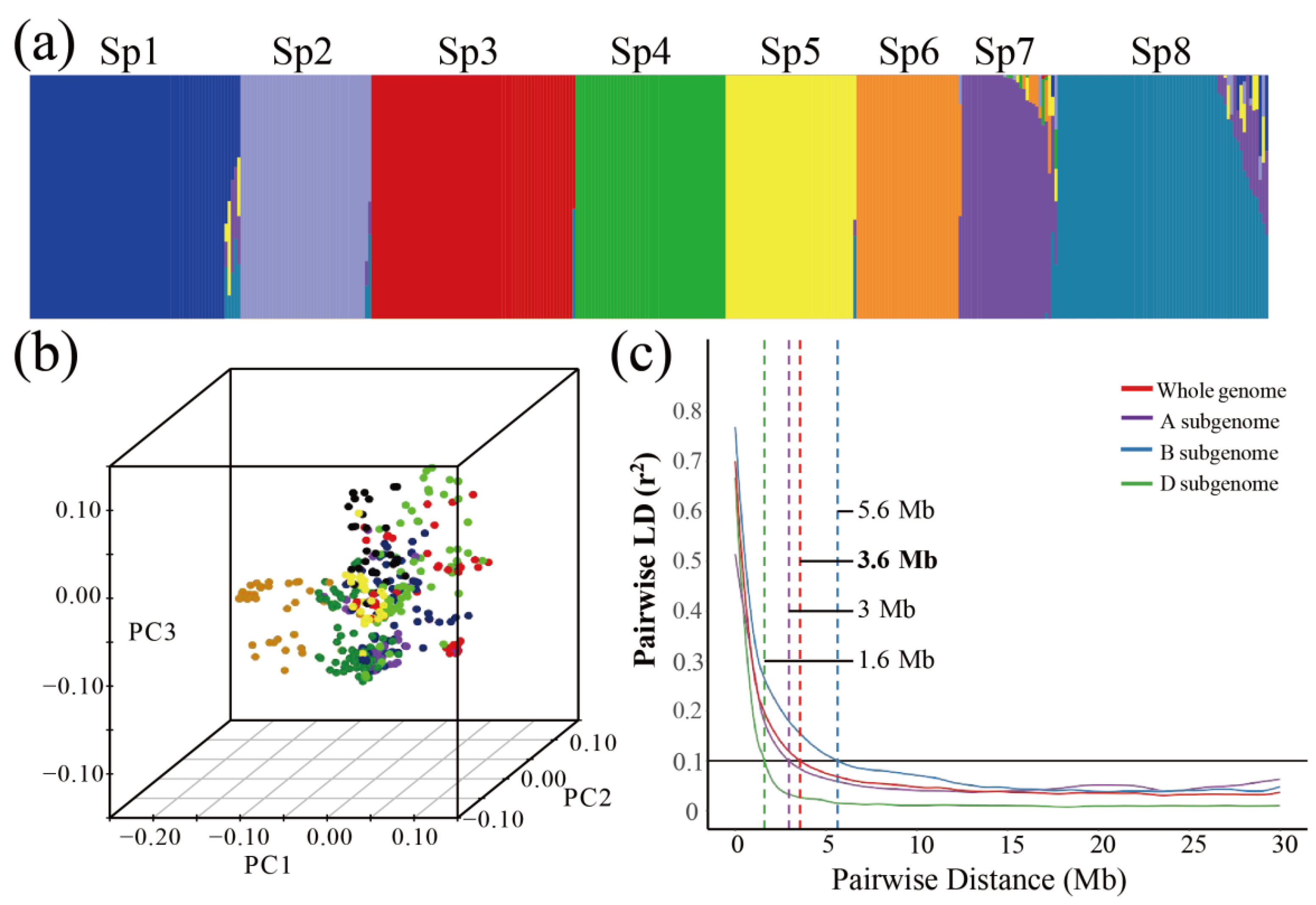
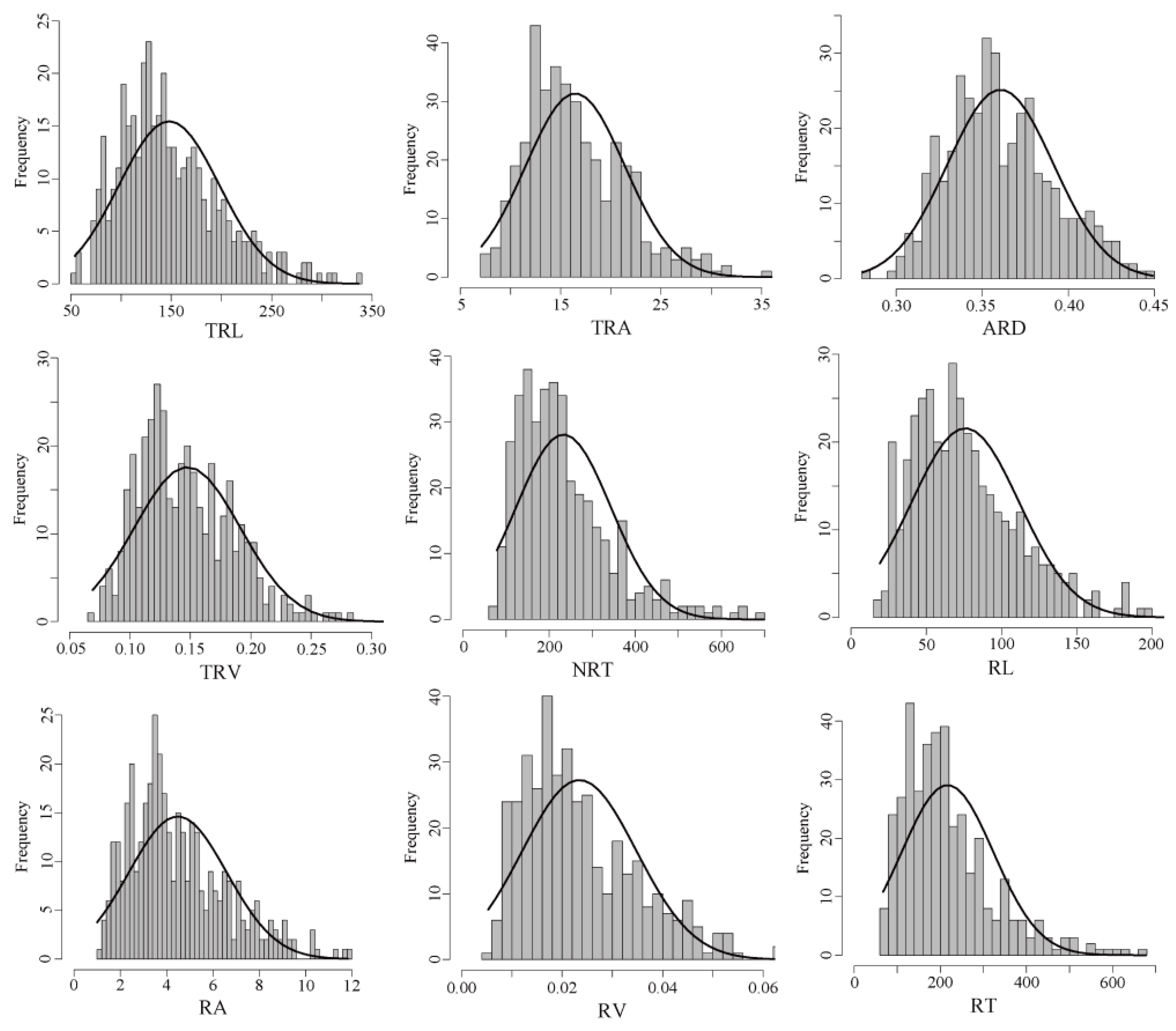
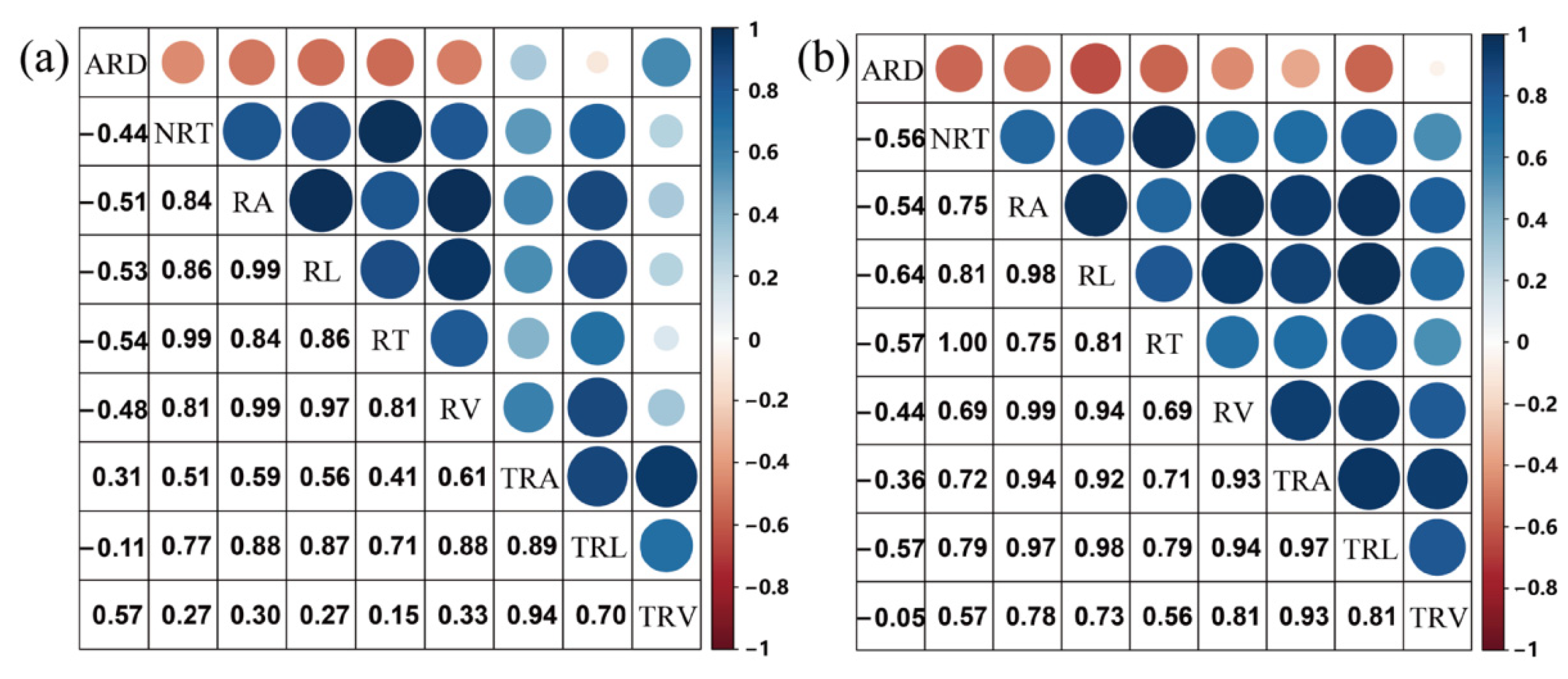
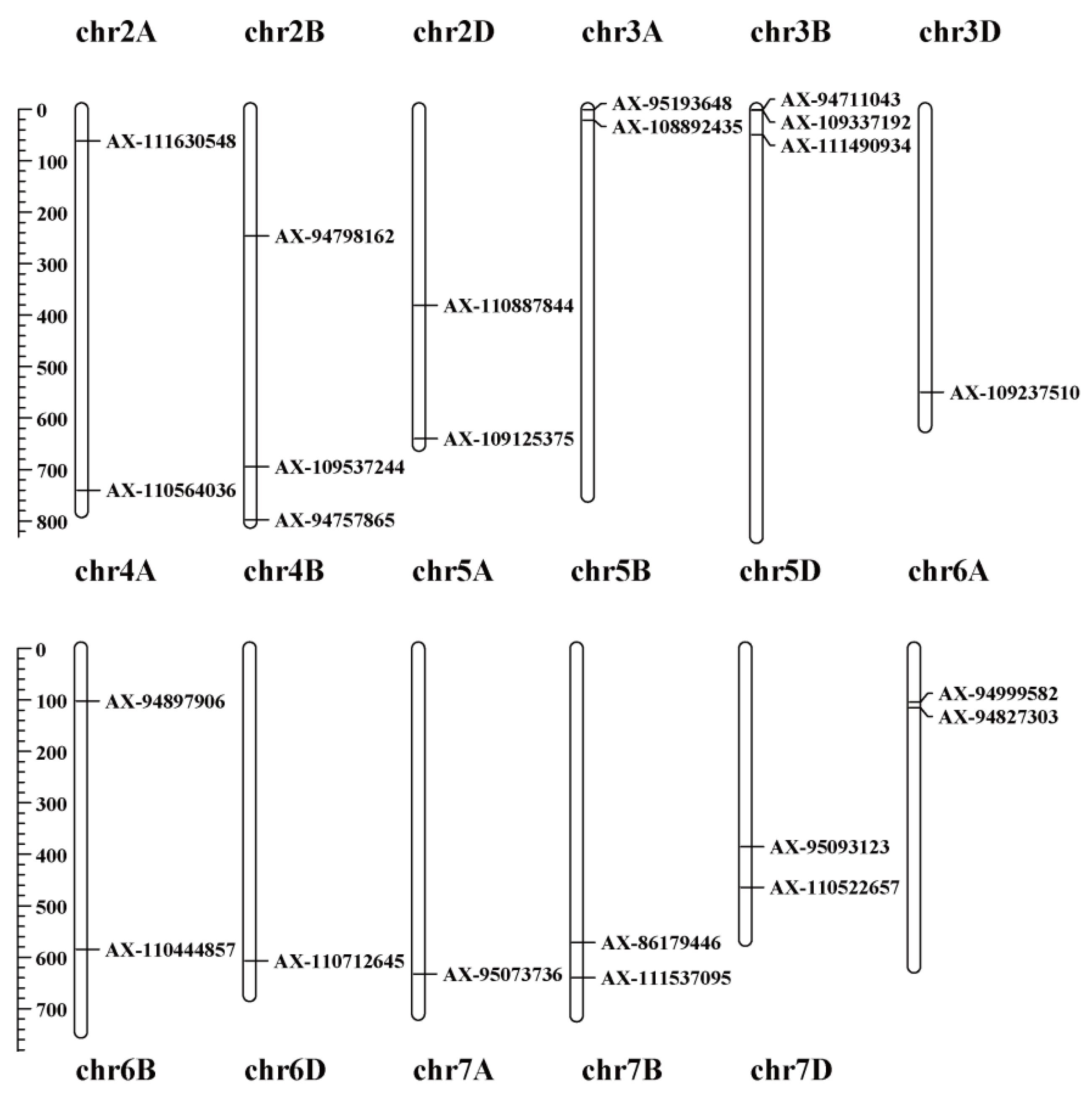
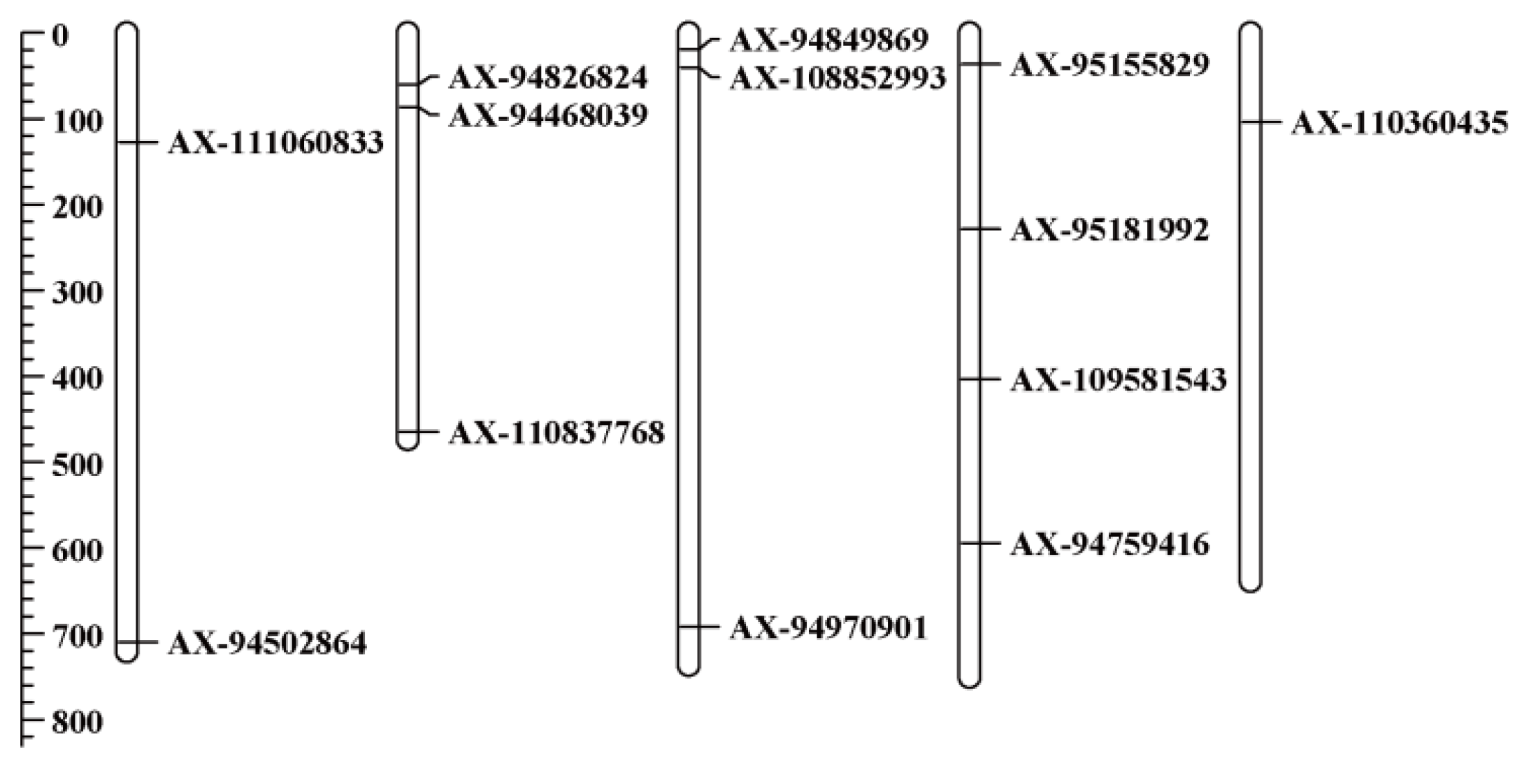

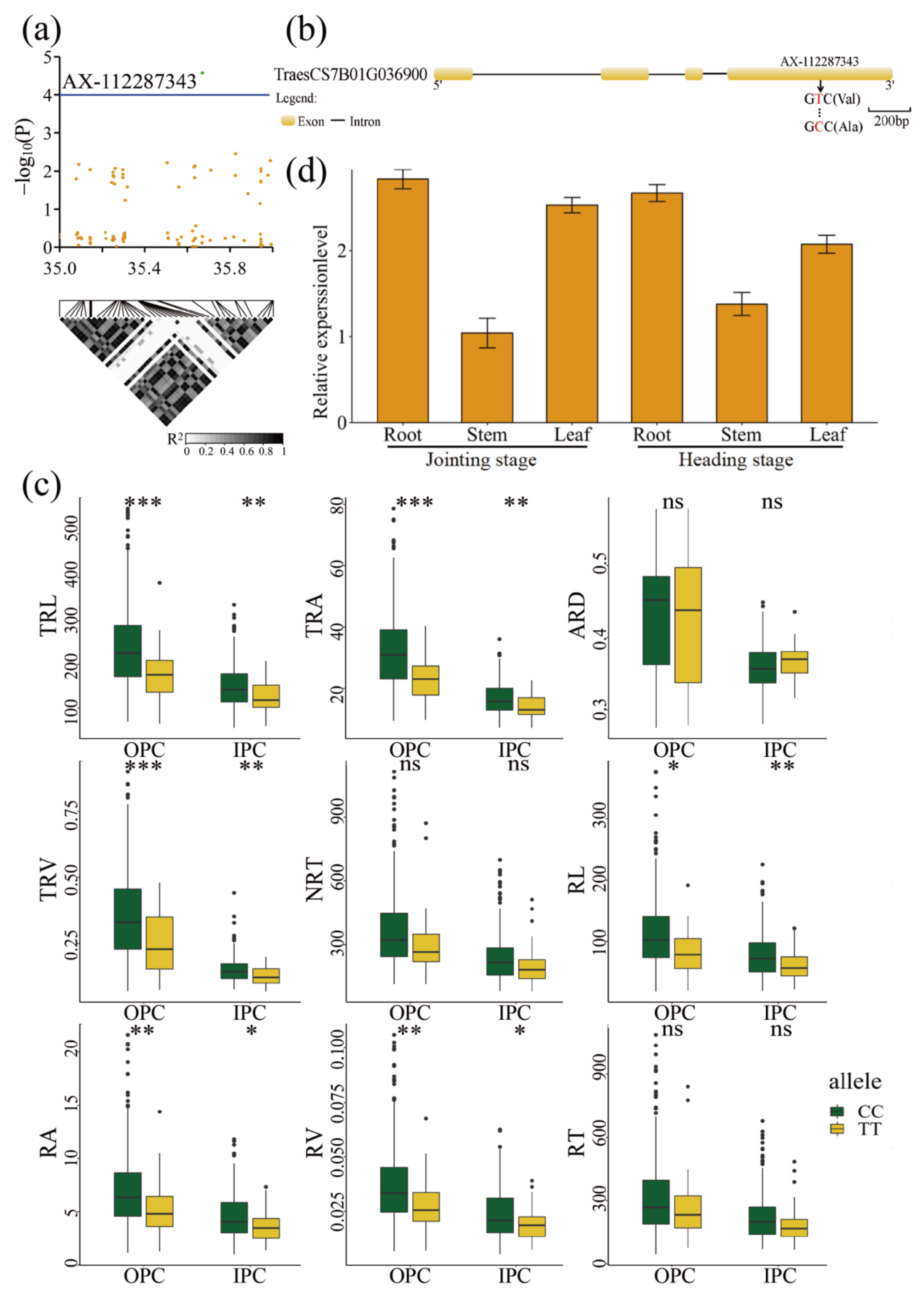
| Sub-Population | Number of Accession | Exotic Variety | Local Landrace | Local Cultivar |
|---|---|---|---|---|
| Sp1 | 66 | 11 | 6 | 49 |
| Sp2 | 41 | 7 | 5 | 29 |
| Sp3 | 64 | 5 | 1 | 58 |
| Sp4 | 47 | 13 | 15 | 19 |
| Sp5 | 41 | 10 | 3 | 28 |
| Sp6 | 33 | 0 | 0 | 33 |
| Sp7 | 30 | 1 | 1 | 28 |
| Sp8 | 66 | 19 | 7 | 40 |
| Trait | E | Mean | SD | Min | Max | bk | bs | CV (%) | H2 (%) | p-Value | <0.001 |
|---|---|---|---|---|---|---|---|---|---|---|---|
| TRL | OPC | 236.06 | 94.96 | 64.25 | 645.14 | 1.84 | 1.14 | 40.22% | 77.83% | 7.96175 × 10−51 | *** |
| IPC | 147.91 | 50.03 | 53.91 | 336.76 | 0.65 | 0.83 | 33.82% | ||||
| TRA | OPC | 31.68 | 12.98 | 9.50 | 86.52 | 1.25 | 0.91 | 40.97% | 76.86% | 2.91719 × 10−81 | *** |
| IPC | 16.45 | 4.93 | 7.11 | 36.00 | 0.55 | 0.80 | 29.94% | ||||
| ARD | OPC | 0.43 | 0.07 | 0.27 | 0.58 | −1.06 | −0.32 | 16.91% | 66.78% | 9.8363 × 10−58 | *** |
| IPC | 0.36 | 0.03 | 0.28 | 0.45 | −0.29 | 0.37 | 8.52% | ||||
| TRV | OPC | 0.35 | 0.17 | 0.07 | 1.09 | 1.51 | 0.95 | 47.94% | 76.86% | 4.92408 × 10−89 | *** |
| IPC | 0.15 | 0.04 | 0.07 | 0.44 | 6.18 | 1.60 | 29.81% | ||||
| NRT | OPC | 360.80 | 186.97 | 113.00 | 1703.67 | 8.55 | 2.20 | 51.82% | 72.38% | 1.24864 × 10−28 | *** |
| IPC | 233.30 | 110.08 | 78.67 | 699.83 | 2.14 | 1.36 | 47.18% | ||||
| RL | OPC | 113.91 | 63.29 | 18.27 | 429.16 | 4.95 | 1.83 | 55.56% | 75.71% | 3.14966 × 10−23 | *** |
| IPC | 75.99 | 35.82 | 19.24 | 225.26 | 1.06 | 0.98 | 47.14% | ||||
| RA | OPC | 6.90 | 3.59 | 1.15 | 24.26 | 3.78 | 1.62 | 52.08% | 76.15% | 6.77309 × 10−28 | *** |
| IPC | 4.48 | 2.11 | 1.01 | 11.82 | 0.44 | 0.89 | 47.13% | ||||
| RV | OPC | 0.04 | 0.02 | 0.0067 | 0.1214 | 3.04 | 1.49 | 50.12% | 76.06% | 7.24198 × 10−31 | *** |
| IPC | 0.02 | 0.01 | 0.0053 | 0.0626 | 0.25 | 0.87 | 48.38% | ||||
| RT | OPC | 311.12 | 187.64 | 45.33 | 1641.83 | 8.30 | 2.20 | 60.31% | 71.15% | 4.80007 × 10−17 | *** |
| IPC | 216.96 | 106.31 | 67.33 | 678.00 | 2.22 | 1.36 | 49.00% |
| Chromosome | No. of Markers | Effective Number | Effective Ratio | Suggested p-Value | % Markers | Length (Mb) | Marker Density | He | PIC |
|---|---|---|---|---|---|---|---|---|---|
| 1A | 28793 | 5643.19 | 0.20 | 1.77 × 10−4 | 7.00 | 594.02 | 48.47 | 0.65 | 0.26 |
| 2A | 28676 | 6088.17 | 0.21 | 1.64 × 10−4 | 6.97 | 780.76 | 36.73 | 0.71 | 0.28 |
| 3A | 19366 | 4607.43 | 0.24 | 2.17 × 10−4 | 4.70 | 750.73 | 25.80 | 0.68 | 0.28 |
| 4A | 17856 | 4241.96 | 0.24 | 2.36 × 10−4 | 4.34 | 744.54 | 23.98 | 0.66 | 0.27 |
| 5A | 22482 | 4935.88 | 0.22 | 2.03 × 10−4 | 5.46 | 709.76 | 31.68 | 0.78 | 0.31 |
| 6A | 16438 | 3851.64 | 0.23 | 2.60 × 10−4 | 3.99 | 617.97 | 26.60 | 0.73 | 0.29 |
| 7A | 28190 | 6297.36 | 0.22 | 1.59 × 10−4 | 6.85 | 736.69 | 38.27 | 0.68 | 0.27 |
| 1B | 20584 | 4750.1 | 0.23 | 2.11 × 10−4 | 5.00 | 689.38 | 29.86 | 0.75 | 0.30 |
| 2B | 28715 | 6701.21 | 0.23 | 1.49 × 10−4 | 6.98 | 801.25 | 35.84 | 0.73 | 0.29 |
| 3B | 45766 | 7920.52 | 0.17 | 1.26 × 10−4 | 11.12 | 830.70 | 55.09 | 0.78 | 0.31 |
| 4B | 13130 | 3016.41 | 0.23 | 3.32 × 10−4 | 3.19 | 673.47 | 19.50 | 0.72 | 0.29 |
| 5B | 33874 | 6596.79 | 0.19 | 1.52 × 10−4 | 8.23 | 713.02 | 47.51 | 0.79 | 0.31 |
| 6B | 25549 | 5554.71 | 0.22 | 1.80 × 10−4 | 6.21 | 720.95 | 35.44 | 0.69 | 0.28 |
| 7B | 17040 | 4491.9 | 0.26 | 2.23 × 10−4 | 4.14 | 750.61 | 22.70 | 0.72 | 0.29 |
| 1D | 10597 | 3058.85 | 0.29 | 3.27 × 10−4 | 2.57 | 495.44 | 21.39 | 0.68 | 0.28 |
| 2D | 10430 | 3731.57 | 0.36 | 2.68 × 10−4 | 2.53 | 651.81 | 16.00 | 0.69 | 0.28 |
| 3D | 7291 | 2668.7 | 0.37 | 3.75 × 10−4 | 1.77 | 615.48 | 11.85 | 0.67 | 0.27 |
| 4D | 4128 | 1702.71 | 0.41 | 5.87 × 10−4 | 1.00 | 509.85 | 8.10 | 0.66 | 0.27 |
| 5D | 8437 | 3285.78 | 0.39 | 3.04 × 10−4 | 2.05 | 566.04 | 14.91 | 0.65 | 0.26 |
| 6D | 7486 | 2940.59 | 0.39 | 3.40 × 10−4 | 1.82 | 473.56 | 15.81 | 0.64 | 0.26 |
| 7D | 10110 | 3669.4 | 0.36 | 2.73 × 10−4 | 2.46 | 638.65 | 15.83 | 0.64 | 0.26 |
| A genome | 161801 | 39.31 | 4934.47 | 32.79 | 0.70 | 0.28 | |||
| B genome | 184658 | 44.86 | 5719.38 | 32.29 | 0.74 | 0.30 | |||
| D genome | 58479 | 14.21 | 3950.83 | 14.80 | 0.66 | 0.27 | |||
| Total | 404938 | 95754.87 | 14,064.68 | 28.79 | 0.70 | 0.28 | |||
| Average | 2.51 × 10−4 |
| Traits | SNP | CHR | Mb | p | −log10 (p) | R2 (%) | Reference |
|---|---|---|---|---|---|---|---|
| ARD | AX-94798162 | 2B | 245.89 | 8.53 × 10−5 | 4.07 | 1.23 | |
| ARD | AX-94757865 | 2B | 797.54 | 6.71 × 10−5 | 4.17–4.38 | 2.24–2.76 | |
| ARD | AX-110887844 | 2D | 380.98 | 7.38 × 10−5 | 4.13 | 2.57 | |
| ARD | AX-109125375 | 2D | 640.04 | 9.95 × 10−5 | 4.00–5.38 | 1.82–3.41 | |
| TRV | AX-108892435 | 3A | 21.28 | 7.86 × 10−5 | 4.10 | 2.58 | |
| ARD | AX-111490934 | 3B | 49.29 | 9.67 × 10−5 | 4.01 | 3.59 | |
| TRV | AX-94897906 | 4A | 102.39 | 9.21 × 10−5 | 4.04 | 2.28 | |
| TRV | AX-110712645 | 4B | 606.85 | 7.29 × 10−5 | 4.14–4.74 | 4.77–5.11 | |
| TRV | AX-95073736 | 5A | 632.60 | 5.59 × 10−5 | 4.25 | 2.64 | |
| TRL | AX-111537095 | 5B | 639.68 | 9.81 × 10−5 | 4.01–4.30 | 4.16–4.95 | |
| ARD | AX-95093123 | 5D | 385.39 | 2.69 × 10−5 | 4.57 | 2.31 | |
| ARD | AX-94999582 | 6A | 104.36 | 6.99 × 10−5 | 4.16 | 4.23 | |
| ARD | AX-94827303 | 6A | 115.18 | 8.43 × 10−5 | 4.07 | 2.84 | |
| ARD | AX-94502864 | 6B | 710.32 | 7.22 × 10−6 | 5.14 | 3.17 | [27] |
| ARD | AX-94826824 | 6D | 60.14 | 5.84 × 10−5 | 4.23 | 2.36 | |
| ARD | AX-94468039 | 6D | 86.37 | 7.64 × 10−5 | 4.12 | 3.18 | |
| ARD | AX-110837768 | 6D | 464.84 | 6.32 × 10−5 | 4.20 | 2.29 | [28] |
| ARD | AX-94849869 | 7A | 19.01 | 7.99 × 10−5 | 4.10 | 3.46 | |
| RT | AX-108852993 | 7A | 40.26 | 7.97 × 10−5 | 4.10 | 3.76 | |
| NRT | AX-94970901 | 7A | 692.05 | 8.53 × 10−5 | 4.07 | 4.03 | [27] |
| RT | AX-95181992 | 7B | 228.81 | 5.95 × 10−5 | 4.23 | 3.84 | |
| ARD | AX-109581543 | 7B | 403.54 | 3.66 × 10−5 | 4.44 | 3.03 | [29] |
| ARD | AX-110360435 | 7D | 104.09 | 9.83 × 10−5 | 4.01 | 2.24 | |
| TRA/TRV | AX-111630548 | 2A | 61.28 | 8.82 × 10−5 | 4.05–4.29 | 2.68–3.20 | |
| TRA/TRV | AX-110564036 | 2A | 740.01 | 8.78 × 10−5 | 4.06–4.11 | 3.41–3.69 | |
| TRA/TRV | AX-109537244 | 2B | 694.26 | 8.70 × 10−5 | 4.06–4.29 | 2.52–2.64 | |
| NRT/RT | AX-95193648 | 3A | 0.56 | 2.39 × 10−5 | 4.62–4.92 | 3.97–4.29 | |
| NRT/RT | AX-94711043 | 3B | 0.99 | 1.17 × 10−5 | 4.93–5.14 | 4.28–4.42 | |
| NRT/RT | AX-109337192 | 3B | 2.28 | 3.94 × 10−5 | 4.40–4.80 | 3.77–4.16 | |
| TRL/RL/RA/RV | AX-109237510 | 3D | 549.74 | 9.90 × 10−5 | 4.00–4.16 | 3.68–4.58 | |
| NRT/RT | AX-110444857 | 4A | 584.71 | 9.92 × 10−5 | 4.00–4.37 | 4.64–4.78 | |
| NRT/RT/RL/RA/RV | AX-86179446 | 5B | 571.23 | 9.98 × 10−5 | 4.00–5.73 | 3.99–6.77 | [28] |
| NRT/RT | AX-110522657 | 5D | 464.07 | 8.90 × 10−5 | 4.05–4.66 | 3.97–5.60 | |
| NRT/RT | AX-111060833 | 6B | 127.23 | 5.66 × 10−5 | 4.25–4.42 | 4.00–4.15 | |
| TRL/TRA | AX-95155829 | 7B | 36.49 | 4.72 × 10−5 | 4.33–4.58 | 4.51–4.80 | |
| TRL/TRA | AX-94759416 | 7B | 594.41 | 8.96 × 10−5 | 4.05–4.23 | 4.00–5.28 |
| Chr | Traits | Reference |
|---|---|---|
| 1A | RGA, TRL, NRT, TRV, RHL, MRL, TRA, ARD | [5,22,23,26,29,30,32,34,35,44,45] |
| 1B | TRL, NRT, RHL, TRA, ARD, TRV, MRL | [5,22,23,26,27,29,32,34,35,36,45] |
| 1D | NRT, TRA, TRL, ARD, NRT, TRA | [28,30,32,37] |
| 2A | TRL, TRV, ARD, TRA, NRT, RGA, MRL | [5,23,30,32,33,34,35,36,37,38,44] |
| 2B | RGA, TRL, TRV, TRA, ARD, NRT, MRL | [5,19,22,23,24,29,30,31,32,33,34,35,37,38,44,45] |
| 2D | TRL, RHL, TRV, TRA, ARD, NRT, MRL | [22,24,26,31,32,33,37,45] |
| 3A | RGA, TRL, NRT, RHL, MRL, TRV, TRA, ARD | [5,22,23,24,26,30,32,33,34,35,36,43,45] |
| 3B | RGA, TRL, NRT, MRL, ARD, TRV, TRA | [5,22,23,24,30,33,34,35,38,39,45] |
| 3D | ARD, TRL, NRT | [32,38,39,45] |
| 4A | RGA, TRL, NRT, TRV, TRA, ARD | [22,23,25,28,30,32,33,34,35,37,38,42,45] |
| 4B | TRL, NRT, ARD, TRA, RGA, TRV | [5,22,23,28,30,31,32,34,35,36,37,39,42,43,45] |
| 4D | TRL, TRA, NRT, MRL, TRV | [31,33,34,38] |
| 5A | TRL, ARD, TRV, NRT, TRA, MRL | [5,19,22,23,25,30,33,34,35,38,45] |
| 5B | RGA, TRL, NRT, TRA, MRL, TRV, TRA, ARD | [22,23,28,29,30,31,32,33,34,35,45,56,58] |
| 5D | TRV, TRL, TRA, ARD, MRL | [22,28,29,32,34,37,45] |
| 6A | RGA, NRT, MRL, TRL, ARD, TRA | [5,22,23,29,31,34,35,36,44] |
| 6B | RGA, TRL, NRT, MRL, RHL, TRA, ARD, TRV | [5,19,22,23,24,26,29,34,35,36,39,43] |
| 6D | NRT, TRL, TRA, ARD, NRT, MRL, RHL | [24,26,28,29,33,34,40,46] |
| 7A | RGA, TRL, NRT, TRA, MRL, ARD, TRV | [5,22,23,24,29,30,31,32,33,34,35,37,39,40,41,42,45] |
| 7B | RGA, NRT, TRL, TRA, MRL, ARD, RHL, TRV | [5,19,22,23,24,26,29,30,31,33,34,35,36,39,45] |
| 7D | NRT, TRA, TRL, TRV, MRL | [22,29,30,32,34,37,38,40,45] |
| Acronym | RSA Traits | Units |
|---|---|---|
| TRL | Total root length | Centimetres (cm) |
| TRA | Total root surface area | Square centimetres (cm2) |
| ARD | Average root diameter | Millimetres (mm) |
| TRV | Total root volume | Cubic centimetres (cm3) |
| NRT | Number of root tips | Number (no.) |
| RL | Root length (root diameter ≤ 0.3 mm) | Centimetres (cm) |
| RA | Root surface area (root diameter ≤ 0.3 mm) | Square centimetres (cm2) |
| RV | Root volume (root diameter ≤ 0.3 mm) | Cubic centimetres (cm3) |
| RT | Root tips (root diameter ≤ 0.3 mm) | Number (no.) |
Publisher’s Note: MDPI stays neutral with regard to jurisdictional claims in published maps and institutional affiliations. |
© 2022 by the authors. Licensee MDPI, Basel, Switzerland. This article is an open access article distributed under the terms and conditions of the Creative Commons Attribution (CC BY) license (https://creativecommons.org/licenses/by/4.0/).
Share and Cite
Ma, J.; Zhao, D.; Tang, X.; Yuan, M.; Zhang, D.; Xu, M.; Duan, Y.; Ren, H.; Zeng, Q.; Wu, J.; et al. Genome-Wide Association Study on Root System Architecture and Identification of Candidate Genes in Wheat (Triticum aestivum L.). Int. J. Mol. Sci. 2022, 23, 1843. https://doi.org/10.3390/ijms23031843
Ma J, Zhao D, Tang X, Yuan M, Zhang D, Xu M, Duan Y, Ren H, Zeng Q, Wu J, et al. Genome-Wide Association Study on Root System Architecture and Identification of Candidate Genes in Wheat (Triticum aestivum L.). International Journal of Molecular Sciences. 2022; 23(3):1843. https://doi.org/10.3390/ijms23031843
Chicago/Turabian StyleMa, Jianhui, Dongyang Zhao, Xiaoxiao Tang, Meng Yuan, Daijing Zhang, Mengyuan Xu, Yingze Duan, Haiyue Ren, Qingdong Zeng, Jianhui Wu, and et al. 2022. "Genome-Wide Association Study on Root System Architecture and Identification of Candidate Genes in Wheat (Triticum aestivum L.)" International Journal of Molecular Sciences 23, no. 3: 1843. https://doi.org/10.3390/ijms23031843
APA StyleMa, J., Zhao, D., Tang, X., Yuan, M., Zhang, D., Xu, M., Duan, Y., Ren, H., Zeng, Q., Wu, J., Han, D., Li, T., & Jiang, L. (2022). Genome-Wide Association Study on Root System Architecture and Identification of Candidate Genes in Wheat (Triticum aestivum L.). International Journal of Molecular Sciences, 23(3), 1843. https://doi.org/10.3390/ijms23031843





